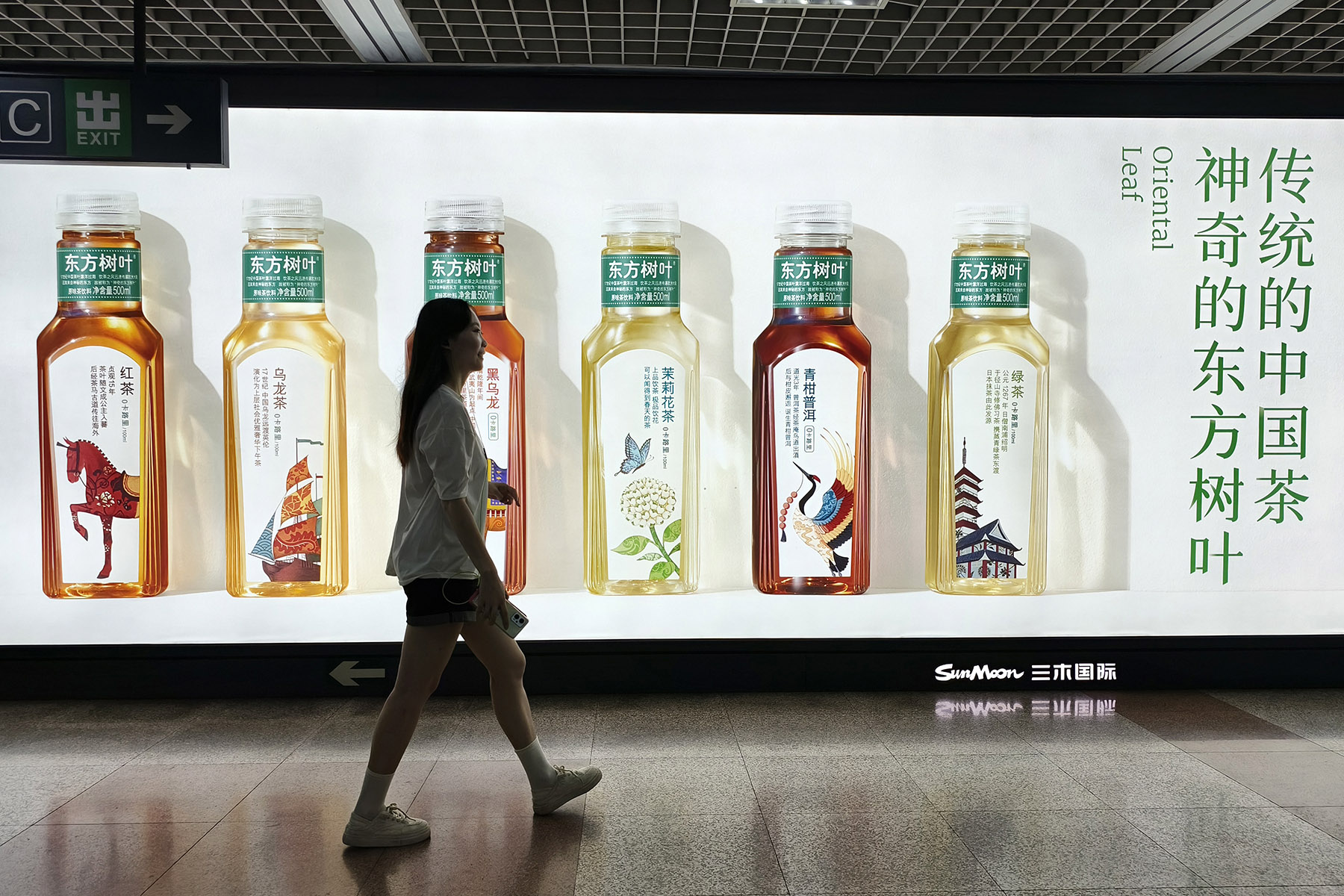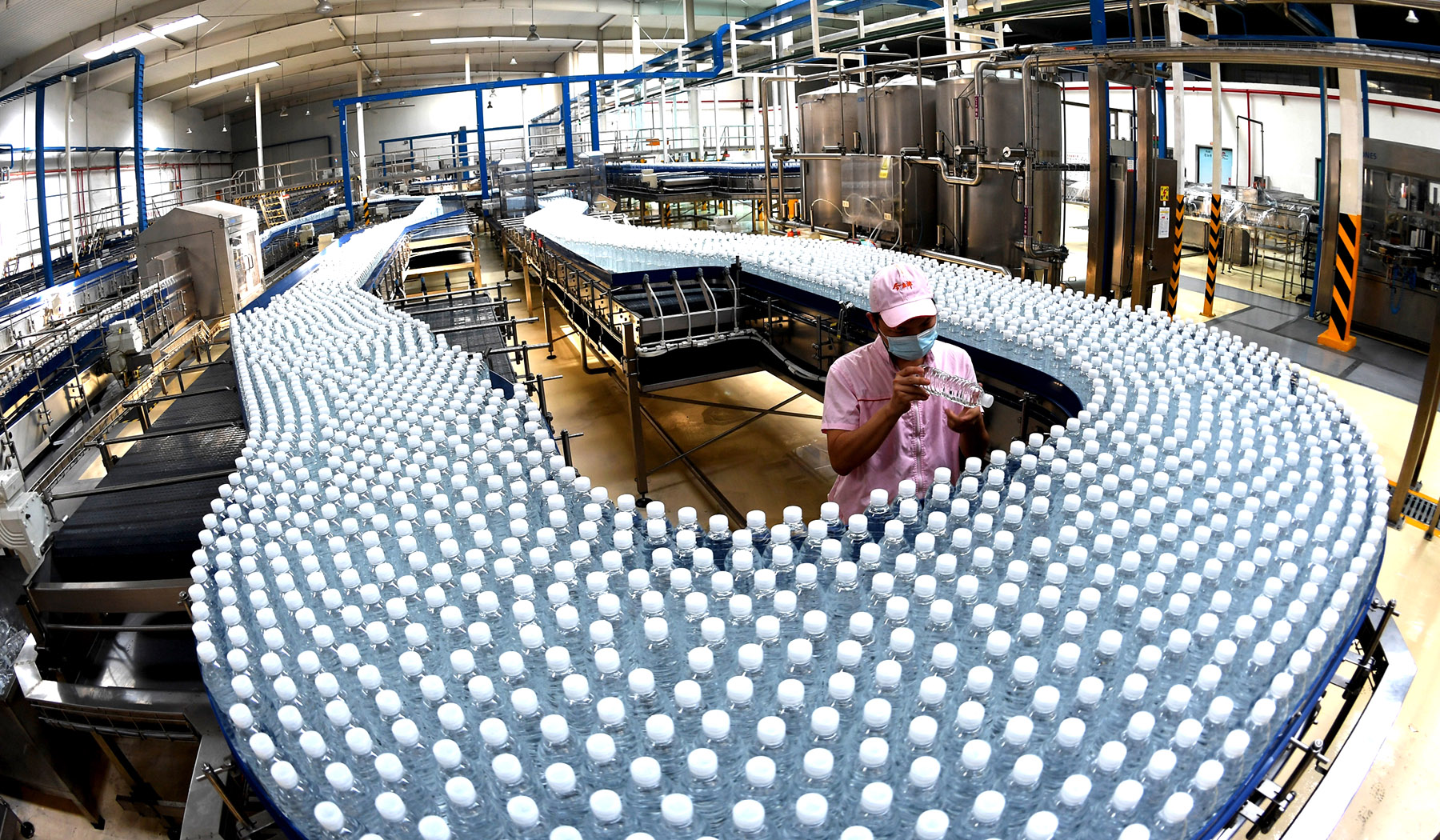The message is clear: bigger means better value for your buck

When a simple bottle of tea trended nationwide recently, it wasn't a new flavor or celebrity endorsement. It was size. Pure, practical size.
The trigger? Oriental Leaf, a popular bottled tea brand owned by beverage giant Nongfu Spring, unleashed a 1.5-liter giant onto shelves and e-commerce platforms.
"Wait, Oriental Leaf comes in 1.5L now? Where can I buy it?" said Zhao Mengxiao, a 31-year-old resident in Beijing after seeing posts on social media platform Sina Weibo.
This isn't just novelty. It's a calculated shift driven by Chinese consumers doing the math.
"It's not that the small bottles aren't affordable," Zhao explained. "The big bottles simply offer better value." She crunched the numbers: the 500ml bottle costs 4.8 yuan ($0.67) in the supermarket; the previous 900ml size is 6.5 yuan. For just 1.7 yuan more, she gets nearly double the tea — a 20 percent savings.
Oriental Leaf's 1.5L bottle takes it even further, equaling three standard 500ml bottles. Prices vary — from roughly 63 yuan for a 6-bottle case online, to regional steals like 9.9 yuan per bottle in Guangdong and Henan provinces or even 3.4 yuan during sales on digital shopping platforms like Meituan.
The message is clear: bigger means better bang for your buck.
ALSO READ: Sugar-free teas evolve into wellness waters, spawning big market
But value alone doesn't explain the frenzy. Beverage packaging designer Wang Qing identifies a key tactic — "physical dominance".
These supersized bottles, Wang noted, are "visual cannonballs". Towering over standard offerings on store shelves, using bold colors and large fonts, they create a visual fault line that's "impossible to ignore" in the crucial seconds of consumer decision-making, he added.
While Oriental Leaf's splash is huge, China's move toward bigger beverages isn't sudden. Early attempts by global players like Coca-Cola's 2L family bottles or Mizone's 1L offerings between 2010 and 2014 saw lukewarm reception.
Back then, health consciousness was lower and alternatives to water replacements were niche. The real shift ignited around 2021. A storm of rising health awareness, pandemic-influenced home consumption and the booming popularity of zero-sugar drinks created fertile ground, according to analysts.
Brands like Chi Forest pushed 1.25L sparkling water for New Year gatherings. China Huiyuan Juice Group Ltd introduced 2L juice options for family get-togethers.
By 2023, Oriental Leaf's 900ml bottle swept store shelves, but consumers still craved more and feedback showed 900ml was "not enough to drink" for all-day hydration. Milk tea chains like Nayuki and Chabaidao answered with 1L fruit teas, cementing large formats as summer staples.
As data from research firm Nielsen show, large bottles from 600ml to 1.25L jumped from 6.4 percent of sales in 2019 to 11.3 percent in 2023, a sector redrawn by scale.
"Once limited to colas, jumbo sizes now span electrolyte waters, coffee and probiotic drinks," said Zhu Keli, founding director of the China Institute of New Economy.
Nearly all major beverage companies have now introduced larger bottle sizes of around 1 liter. This year, Nongfu Spring has further upsized its packaging, evolving from the standard 1 liter and 1.25-liter bottles to a 1.5-liter option.
Hema Fresh, the supermarket chain owned by Alibaba Group, has also stepped up, now offering a 2-liter sugar-free tea.
Jumbo-sized beverage packaging has entered a phase of rapid expansion and mainstream adoption in the current consumer market. This developmental trajectory has become an industry-wide consensus, characterized by surging market share and pervasive category penetration, Zhu added.
While consumers relish the perceived value, supersized packaging has also offered the beverage industry a solution to weathering the storm of rising costs.

El Nino — a periodic warming of Pacific Ocean currents — on the climate system hit global sugar giants like India and Thailand hard, slashing yields and sending prices soaring. In 2023, white sugar in China hit 7,390 yuan per metric ton — a 13-year peak. Sugar alone makes up about 15 percent of a soft drink's cost, said Zhang Yuguang, chief analyst in the food and beverage sector at Kaiyuan Securities.
Crude oil volatility sent the prices of PET plastic, the lifeblood of bottles, skyrocketing. Industry leader Nongfu Spring repeatedly cited PET costs as the primary driver for price adjustments in its 2022-23 reports, Zhang added.
While prices of some materials like PET and sugar have eased slightly recently, Zhang stressed costs remain stubbornly higher than pre-2020 levels. This sustained pressure forced brands to act.
Coca-Cola raised prices multiple times in 2023-24. Its iconic 500ml bottle climbed from 3 yuan to between 3.5 yuan and 4.2 yuan — a hike of up to 16 percent.
Nongfu Spring and Master Kong raised prices on their 1 liter tea drinks from 4 yuan to 5 yuan. Wahaha Group downsized bottles or introduced smaller mini packs but kept the price the same.
Amidst these pressures, the humble large bottle has emerged as a surprisingly effective weapon.
Food and beverage analyst Zhu Danpeng said that the larger the bottle, the smaller the proportion of its cost goes into the packaging itself.
For a 1.5L bottle, packaging costs drop to just 15 percent of the total cost. For a standard 500ml bottle, it's a higher 22 percent. When material costs soar, this difference is crucial. Big bottles dilute the impact, according to Zhu.
Large bottles aren't just bigger; they're often engineered stronger. Bottoms feature thicker, reinforced anti-slip patterns. This drastically reduces crushing and deformation during transit, Zhu added.
This packaging revolution found its perfect battlefield: China's vast lower-tier cities and rural areas. Here, big bottles aren't just economical, they're practical for larger families.
In Xingtai, Hebei province, Liu Yuanyuan loads her shopping cart. As a teacher supporting three generations under one roof — seven people in total — her choices are deliberate. She headed straight for the towering bottles and familysized packages.
"The big bottle of iced tea is a sensible choice," Liu said, her cart filling with large containers. "With three children, a small bottle vanishes in minutes."
ALSO READ: Chinese beverage, snack companies going overseas
However, bigger doesn't always mean better, especially when it comes to bigger cities like Beijing and Shanghai.
Chen Wei, a finance manager in Shanghai, avoids large bottles since it's just him and a dog living together.
"They're heavy to carry on subways, and they would only make my fridge full of beverage leftovers at the end of the day: half-finished cola, oxidized juice, flat sparkling water," he said. "Small bottles can also help me control my sugar intake."
Jumbo bottles excel at delivering value and meeting the needs of price-sensitive consumers in lower-tier regions, while smaller packages cater to the convenience, health and social attributes sought by urbanites, said Zhu, who is with the China Institute of New Economy.
By tailoring their offerings to the specific needs and preferences of different consumer segments, beverage brands can better position themselves to capitalize on the diverse growth opportunities across the market, Zhu added.
Contact the writer at wangkeju@chinadaily.com.cn


